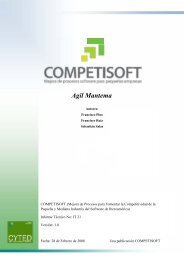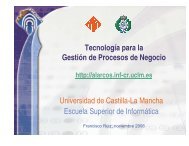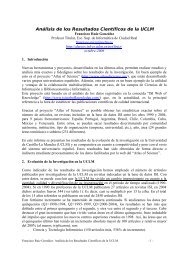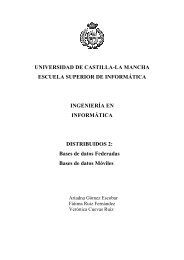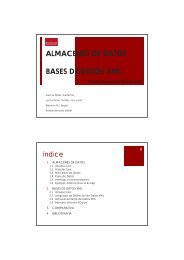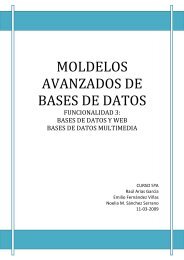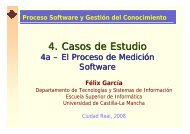You also want an ePaper? Increase the reach of your titles
YUMPU automatically turns print PDFs into web optimized ePapers that Google loves.
<strong>EL</strong> <strong>FUTURO</strong> <strong>DE</strong> <strong>LAS</strong> <strong>BASES</strong> <strong>DE</strong> <strong>DATOS</strong><br />
PORTADA<br />
<strong>EL</strong> <strong>FUTURO</strong> <strong>DE</strong> <strong>LAS</strong><br />
<strong>BASES</strong> <strong>DE</strong> <strong>DATOS</strong><br />
(c) Dr. Mario Piattini y Dra. Coral Calero 1<br />
<strong>EL</strong> <strong>FUTURO</strong> <strong>DE</strong> <strong>LAS</strong> <strong>BASES</strong> <strong>DE</strong> <strong>DATOS</strong> INDICE<br />
1.- INTRODUCCIÓN<br />
2.- EVOLUCIÓN <strong>DE</strong> LA GESTIÓN <strong>DE</strong> <strong>DATOS</strong><br />
3.- NUEVOS RETOS<br />
3.1.- Señales de preocupación<br />
3.2.- Cambios en el entorno empresarial<br />
3.3.- Avances en el hardware y las comunicaciones<br />
3.4.- Datos mal gestionados<br />
4.- FACTORES Y LÍNEAS <strong>DE</strong> EVOLUCIÓN<br />
5.- MADUREZ <strong>DE</strong> <strong>LAS</strong> NUEVAS TECNOLOGÍAS<br />
(c) Dr. Mario Piattini y Dra. Coral Calero 2
<strong>EL</strong> <strong>FUTURO</strong> <strong>DE</strong> <strong>LAS</strong> <strong>BASES</strong> <strong>DE</strong> <strong>DATOS</strong> INTRODUCCION<br />
TECNOLOGÍA <strong>DE</strong> <strong>LAS</strong> <strong>BASES</strong> <strong>DE</strong> <strong>DATOS</strong><br />
. Excepcional productividad<br />
. Impresionante impacto económico<br />
- 8.000M $ y 20% de crecimiento<br />
. Grandes inversiones<br />
- Aplicaciones desarrolladas con SGBD<br />
- Investigación y Desarrollo<br />
- Marketing<br />
<strong>LAS</strong> <strong>BASES</strong> <strong>DE</strong> <strong>DATOS</strong> SE HAN CONVERTIDO EN<br />
UN PRODUCTO ESTRATÉGICO <strong>DE</strong> PRIMER OR<strong>DE</strong>N<br />
(c) Dr. Mario Piattini y Dra. Coral Calero 3<br />
<strong>EL</strong> <strong>FUTURO</strong> <strong>DE</strong> <strong>LAS</strong> <strong>BASES</strong> <strong>DE</strong> <strong>DATOS</strong> EV. GESTION <strong>DE</strong> <strong>DATOS</strong><br />
- GESTIÓN <strong>DE</strong> <strong>LAS</strong> EMPRESAS CON COBOL<br />
- PROCESOS <strong>DATOS</strong><br />
- GENERACIONES <strong>DE</strong> <strong>BASES</strong> <strong>DE</strong> <strong>DATOS</strong><br />
1ª SGBD EN RED<br />
2ª SGBD R<strong>EL</strong>ACIONALES<br />
3ª SGBD INT<strong>EL</strong>IGENTES, ACTIVOS,<br />
ORIENTADOS A OBJETOS, ...<br />
(c) Dr. Mario Piattini y Dra. Coral Calero 4
<strong>EL</strong> <strong>FUTURO</strong> <strong>DE</strong> <strong>LAS</strong> <strong>BASES</strong> <strong>DE</strong> <strong>DATOS</strong> EV. GESTION <strong>DE</strong> <strong>DATOS</strong><br />
3ª GENERACIÓN <strong>DE</strong> <strong>BASES</strong> <strong>DE</strong> <strong>DATOS</strong><br />
“Proporciona capacidades de gestión de datos al igual que sus<br />
predecesoras, permitiendo que grandes cantidades de datos<br />
persistentes sean compartidos por muchos usuarios. También<br />
proporcionan gestión de objetos, permitiendo tipos de datos<br />
muchos más complejos, objetos multimedia, datos derivados,<br />
encapsulamiento de la semántica de los datos, así como otras<br />
nuevas capacidades. Algunos proporcionan incluso gestión de<br />
conocimiento, soportando un gran número de reglas complejas<br />
para inferencia automática de información y mantener las<br />
restricciones de integridad entre datos”<br />
Cattell (1991)<br />
(c) Dr. Mario Piattini y Dra. Coral Calero 5<br />
<strong>EL</strong> <strong>FUTURO</strong> <strong>DE</strong> <strong>LAS</strong> <strong>BASES</strong> <strong>DE</strong> <strong>DATOS</strong> EV. GESTION <strong>DE</strong> <strong>DATOS</strong><br />
3ª GENERACIÓN <strong>DE</strong> <strong>BASES</strong> <strong>DE</strong> <strong>DATOS</strong><br />
“Gestiona información de una manera natural, haciendo esta<br />
información fácil de almacenar, acceder y utilizar. Es necesario:<br />
- Un fuerte soporte para texto, imagen, voz, animación y vídeo<br />
- Un modelo de bases de datos orientado al objeto<br />
- Un soporte de reglas declarativas para expresar las<br />
interrelaciones semánticas entre objetos”<br />
Khoshafian et al. (1990)<br />
(c) Dr. Mario Piattini y Dra. Coral Calero 6
<strong>EL</strong> <strong>FUTURO</strong> <strong>DE</strong> <strong>LAS</strong> <strong>BASES</strong> <strong>DE</strong> <strong>DATOS</strong> NUEVOS RETOS<br />
SEÑALES <strong>DE</strong> PREOCUPACIÓN<br />
Buchmann (1996)<br />
- Los SGBD son monolíticos<br />
- Existen más datos en hojas de cálculo que en SGBD<br />
- El 50% de los datos en producción están en sistemas<br />
heredados (legacy systems)<br />
- Muchas aplicaciones no necesitan más que ficheros<br />
- Los servicios de réplica no escalan por encima de los<br />
10.000 nodos<br />
- No se puede combinar datos estructurados y no<br />
estructurados<br />
(c) Dr. Mario Piattini y Dra. Coral Calero 7<br />
<strong>EL</strong> <strong>FUTURO</strong> <strong>DE</strong> <strong>LAS</strong> <strong>BASES</strong> <strong>DE</strong> <strong>DATOS</strong><br />
CAMBIOS EN <strong>EL</strong> ENTORNO EMPRESARIAL<br />
Keen (1985)<br />
- Flexibilidad organizacional<br />
- Adaptación al cambio<br />
- Cobertura<br />
- Extensiones inter-empresa<br />
- Cooperaciones y alianzas<br />
- Procesos integrados<br />
- Gestión integrada y consistente<br />
EMPRESA ABIERTA<br />
NUEVOS RETOS<br />
(c) Dr. Mario Piattini y Dra. Coral Calero 8
<strong>EL</strong> <strong>FUTURO</strong> <strong>DE</strong> <strong>LAS</strong> <strong>BASES</strong> <strong>DE</strong> <strong>DATOS</strong><br />
HARDWARE Y COMUNICACIONES<br />
- LEYES <strong>DE</strong> LA EVOLUCIÓN D<strong>EL</strong> HARDWARE:<br />
- Ley de Moore<br />
NUEVOS RETOS<br />
- Ley de Hoagland<br />
- Ley de Joy<br />
- Predicción de Gray<br />
- MÁQUINAS PARAL<strong>EL</strong>AS<br />
- TÉCNICAS <strong>DE</strong> COMPRESIÓN<br />
- DISPOSITIVOS <strong>DE</strong> ALMACENAMIENTO ÓPTICO<br />
- DIGITALIZADORES <strong>DE</strong> AUDIO Y VÍ<strong>DE</strong>O<br />
(c) Dr. Mario Piattini y Dra. Coral Calero 9<br />
<strong>EL</strong> <strong>FUTURO</strong> <strong>DE</strong> <strong>LAS</strong> <strong>BASES</strong> <strong>DE</strong> <strong>DATOS</strong><br />
<strong>DATOS</strong> MAL GESTIONADOS<br />
Zachman (1996)<br />
NUEVOS RETOS<br />
- El 70% de los informes se utilizan para volver a<br />
introducir datos en bases de datos<br />
- 80/90% del tiempo se dedica al mantenimiento<br />
- 60/70% se dedica a mantener interfaces y transformar<br />
datos de una base a otra<br />
- 100M$ a “parchear” progs. por errores al pasar datos<br />
- 70% de las líneas de código sólo mueven datos<br />
- 20/40% de toda la mano de obra de EEUU se dedica<br />
a recoger, almacenar, recuperar, ... información<br />
(c) Dr. Mario Piattini y Dra. Coral Calero 10
<strong>EL</strong> <strong>FUTURO</strong> <strong>DE</strong> <strong>LAS</strong> <strong>BASES</strong> <strong>DE</strong> <strong>DATOS</strong> LÍNEAS <strong>DE</strong> EVOLUCIÓN<br />
PRODUCTOS<br />
FACTORES CLAVE<br />
FUNDAMENTOS<br />
TEÓRICOS<br />
APLICACIONES<br />
PRÁCTICAS<br />
(c) Dr. Mario Piattini y Dra. Coral Calero 11<br />
<strong>EL</strong> <strong>FUTURO</strong> <strong>DE</strong> <strong>LAS</strong> <strong>BASES</strong> <strong>DE</strong> <strong>DATOS</strong> LÍNEAS <strong>DE</strong> EVOLUCIÓN<br />
FUNDAMENTOS<br />
TEÓRICOS<br />
Modelos de Referencia Modelos de datos<br />
ANSI<br />
ISO<br />
...<br />
Jerárquico<br />
Codasyl<br />
Relacional<br />
Orientado a Objetos<br />
...<br />
ESTRUCTURA Y ESTANDARIZACIÓN<br />
(c) Dr. Mario Piattini y Dra. Coral Calero 12
<strong>EL</strong> <strong>FUTURO</strong> <strong>DE</strong> <strong>LAS</strong> <strong>BASES</strong> <strong>DE</strong> <strong>DATOS</strong> LÍNEAS <strong>DE</strong> EVOLUCIÓN<br />
DISTRIBUCIÓN/<br />
INTEGRACIÓN<br />
FUNCIONALIDAD/<br />
INT<strong>EL</strong>IGENCIA<br />
BD<br />
RENDIMIENTO<br />
(c) Dr. Mario Piattini y Dra. Coral Calero 13<br />
<strong>EL</strong> <strong>FUTURO</strong> <strong>DE</strong> <strong>LAS</strong> <strong>BASES</strong> <strong>DE</strong> <strong>DATOS</strong> LÍNEAS <strong>DE</strong> EVOLUCIÓN<br />
RENDIMIENTO<br />
- BD PARAL<strong>EL</strong>AS<br />
- BD EN TIEMPO REAL<br />
- BD EN MEMORIA PRINCIPAL<br />
(c) Dr. Mario Piattini y Dra. Coral Calero 14
<strong>EL</strong> <strong>FUTURO</strong> <strong>DE</strong> <strong>LAS</strong> <strong>BASES</strong> <strong>DE</strong> <strong>DATOS</strong> LÍNEAS <strong>DE</strong> EVOLUCIÓN<br />
DISTRIBUCIÓN<br />
- BD DISTRIBUIDAS<br />
- BD FE<strong>DE</strong>RADAS<br />
- MULTI<strong>BASES</strong> <strong>DE</strong> <strong>DATOS</strong><br />
- BD MÓVILES<br />
- BD Y “WEB”<br />
(c) Dr. Mario Piattini y Dra. Coral Calero 15<br />
<strong>EL</strong> <strong>FUTURO</strong> <strong>DE</strong> <strong>LAS</strong> <strong>BASES</strong> <strong>DE</strong> <strong>DATOS</strong> LÍNEAS <strong>DE</strong> EVOLUCIÓN<br />
INT<strong>EL</strong>IGENCIA<br />
- BD ACTIVAS<br />
- BD <strong>DE</strong>DUCTIVAS<br />
- BD ORIENTADAS A OBJETOS<br />
- BD MULTIMEDIA<br />
- BD TEMPORALES<br />
- BD SEGURAS<br />
- BD DIFUSAS<br />
- ALMACENES <strong>DE</strong> <strong>DATOS</strong><br />
(c) Dr. Mario Piattini y Dra. Coral Calero 16
<strong>EL</strong> <strong>FUTURO</strong> <strong>DE</strong> <strong>LAS</strong> <strong>BASES</strong> <strong>DE</strong> <strong>DATOS</strong> MADUREZ<br />
PLANO INDUSTRIAL<br />
PLANO CIENTÍFICO<br />
BD<br />
PLANO COMERCIAL<br />
(c) Dr. Mario Piattini y Dra. Coral Calero 17



